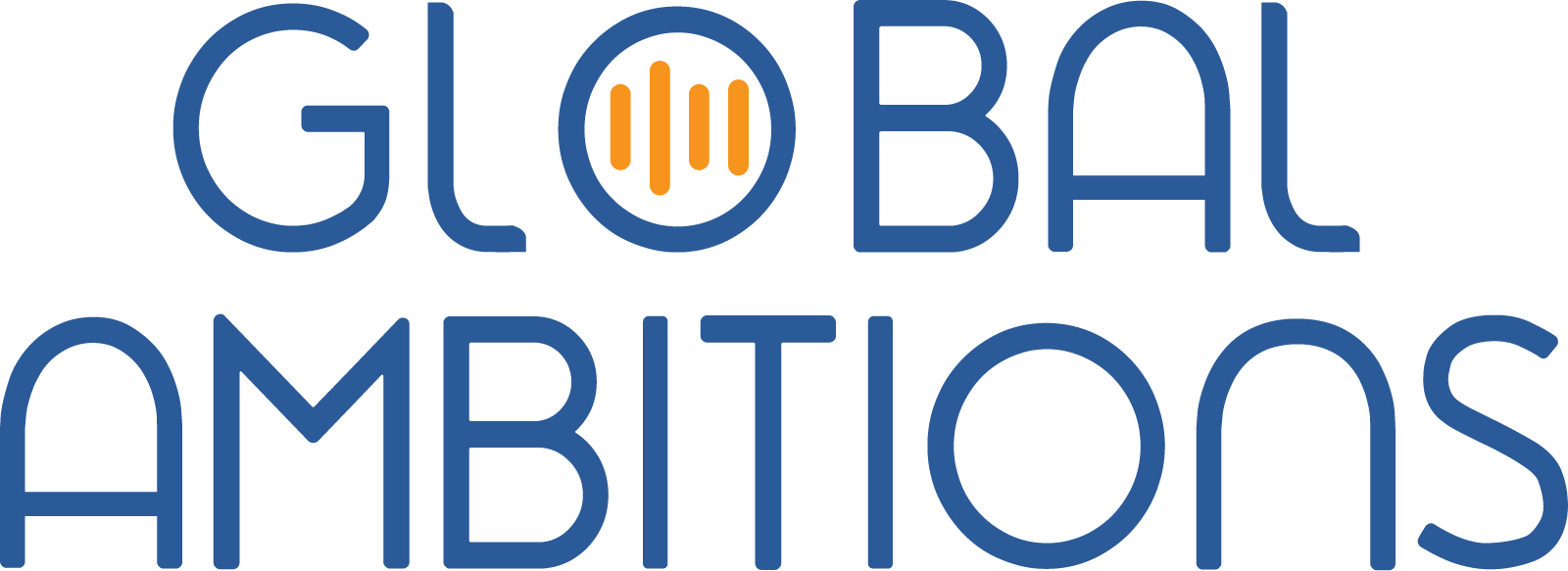With Aileen Hackett, Experienced Product and Program Management Leader
Below is an automated transcript of this episode
Stephanie Harris: 0:04
Hi, my name is Stephanie Harris and I’ll be your host today with this episode of Global Ambitions. Our guest today is Aileen Hecket, who is the Director of Product Management for Accessibility at ServiceNow. Aileen, welcome to the program.
Aileen Hackett: 0:33
Thank you so much for having me, Stephanie.
Stephanie: 0:35
So first off, I want to admit that I am somewhat ignorant about all that goes into accessibility and designing systems to be accessible. Can you tell us a little bit about what your day-to-day work looks like at ServiceNow? What is ServiceNow doing in these terms of accessibility?
Aileen: 0:54
Great. Love the opportunity to talk about accessibility. I’m very passionate about the subject. I’m delighted to work in this field. I’ve worked before at ServiceNow developing our design system and doing that making our UI accessible was a part of that, and now I’m delighted to be working full-time in accessibility. And so at ServiceNow, we make the world of work better for everyone. That’s our mission, and to truly make the world of work work better for everyone, we need to be inclusive and make sure that people with disabilities have the same access to software as everybody else.
So part of that is looking at all disabilities. I mean you may know that the World Health Organization says that 1.3 billion people experience some kind of significant disability, so the number is probably a lot higher than that when you think of all the disabilities that there are out there. In fact, as the population ages as well, there’s evidence that people need more assistive technology as they use software. And so at ServiceNow, we look at all of types of disabilities, so we’re making sure that our software works, whether you are somebody who has visual impairment, or auditory, or speech, or cognitive and, of course, physical as well. So we look at all the different types of disabilities. You might have a combination of disabilities and we want to make sure that our software works for everyone. It’s really our mission and our goal.
Stephanie: 2:32
It sounds like this is very much tied into just your DNA as ServiceNow and how you want to respond to customers, but it must have been a real big step to jump into “Yes, we’re going to take on this project. This is something that we’re really going to do!” Were there other factors that also played into? Yes, now this is the time, like you mentioned. Is there legal reasons that happened or other reasons that you had certain use cases, that you ran into issues, or what can you tell us a little bit about the story around that?
Aileen: 3:03
Sure, you know, I feel like there’s lots of reasons why people should make accessible software. Of course it’s the right thing to do, but there’s also, you know, legally there’s reasons why you want to make accessible software where mandated in the US through 508. In other companies they have other acts around disability and so there’s legal reasons to do it as well. But at ServiceNow it really we always worked on accessibility, so we were always intending to make the software accessible and you know there was that people were testing for that. But I think why we set up this accessibility focus group accessibility COE at the end of 2021 was driven in partnership with our DEI team. So diversity, equity, inclusion we set up a new diversity, equity and inclusion department at ServiceNow and part of being inclusive is having inclusive software and we wanted to make sure that you know we were prioritizing that for our customers and also internally for our employees as well.
So we do both. We, you know, are interested in making our customer facing software accessible, but also making sure that our own employees have the best experience as well. And proud to be voted recently as one of the best places to work ServiceNow was voted that recently and also for accessibility, we were a finalist in a recent Inclusive Software Award and for AbilityNetTech for Good Awards. We are finalists in that, so we’re doing a lot of the right things. So it’s not only just about you know. I think of course the driver is We want to all do the right thing, but when your leadership backs you and says you know, this is really important for us as a company as well, it enables you to be able to devote time to doing that.
Stephanie: 4:56
So what has been the biggest challenge that you’ve encountered in developing a product that’s accessible?
Aileen: 5:03
Yeah, I’ve talked a lot about this with people in the accessibility community, because what’s great about the accessibility community as well is that we’re, all you know, want to do the right thing, and it’s a great community for sharing ideas and learnings. And one of the things that I’ve learned is that you know, fundamentally, people have different triggers to why they want to do something, and so you have to speak to that. So if you’re speaking to people that you need to influence and motivate to work on making their software more accessible, you know what could be a driver for them might be return on investment, and, of course, there is a huge return on investment if you make accessible software, then more companies want to buy it, especially, you know, in the public sector and other areas. So if that’s what appeals to the person you need to influence, you need to use that. If what appeals to the person that you’re working with is the ability to make something more usable from a design perspective, if you’re talking to designers like they want to make the most beautiful usable experience for all and you would discuss that.
So I think, pivoting to whatever is the driver for the person that you’re talking to, that you need to get on board the accessibility journey with you. So maybe in the past what was challenging is, you know, people were maybe looking at these defects and from a defect mindset, like we’ve got these problems, these issues, and that doesn’t always resonate with so many people. I think looking at it as an opportunity as well is a better way of presenting it. Opportunity to win business, opportunity to be seen as a leader in the space, opportunity to help people’s lives, opportunity to bring more people into your workforce. If you, there’s this great talent of people that are being excluded right now and we need more people in the workforce to do jobs and work for us. You know, I think converting things from you know, being an issue to being an opportunity is my advice.
Stephanie: 7:14
Yeah, for sure. As you were going along and really maturing out this program, did you encounter any hurdles or other like missteps on “Oh, we shouldn’t have done it that way. This is maybe a better way to do it” along the way that you can caution people as they’re just starting out on their journey|?
Aileen: 7:33
Yeah, I think you know, in going from being reactive to proactive. So I think we were spending circles in the past on trying to fix problems and you really have to go back to the roots. And so when we brought in Emma McElene’s my boss he’s the head of accessibility at ServiceNow and we kicked off this new accessibility COE with Amiella Tannasov as well, who’s the VP of accessibility engineering. You know what we did with them and coming up with this accessibility COE was really go back to the roots and try to shift left. So we talk about shifting left a lot and what that means is you need to bake in accessibility from the beginning. When you’re planning a new feature, when you’re designing a new component or a new page, that’s when you need to be thinking about accessibility and being reactive. And having this manpower to work on defects is not the way. One of the fundamental things we learned, Stephanie, was making sure people had the skills because accessibility there’s great guidelines out there. The WC Publish, WCAD guidelines which are very prescriptive and tell you what you need to do, but a lot of engineers haven’t had, or designers may not have had, exposure to accessibility. So one of the first things we did was make sure that we had a good training program. So my advice to anybody who’s thinking of renewing their accessibility program or starting an accessibility program at their company is invest in a good training program.
So having that and making sure that there’s an opportunity for people to take it as well, and making sure that it’s relevant to them so tailoring it to their experiences is really important. So I think we did a good job with that, rolling out this new training program. We actually had made it mandatory for everyone at Service Now to take the overview of accessibility, so every employee gets asked to understand at least the fundamentals about accessibility. And then we have bespoke training, whether it’s depending on your role if you’re an engineer or a designer or a product manager and we have bespoke training that relates to your role. But I think that’s one area I would say making sure that you’ve got a really good training program. Another area is looking at your software development lifecycle, so looking at opportunities to embed accessibility in your software development lifecycle. As part of that shifting left, we were trying to model a little bit like what we do with security or performance. We actually very well embed it. You know as people go through. You know the process of planning to design, to development, to testing, to hardening, to release. There’s various checkpoints along the way, or guardrails that you know help you to ensure that the end result is performant or is secure and likewise can help you to make sure that your end product is accessible. So we time looking at our software development lifecycle and finding areas that we could put in more guardrails, and I think that’s an important step to take as well.
Stephanie: 10:53
So how do you measure success with all of this? It sounds like there’s a lot that goes into it, but how do you know if it’s working, if you’re achieving those goals that you put in?
Aileen: 11:01
Well, one really important step is you know we’re doing this to help people who have disabilities, so having them engaged in the process is really important, because I can stand here and say, from a conformance guidelines point of view, I’ve ticked all the boxes, but, you know, as a user who relies on a screen reader or as a user who relies on a keyboard to do their work, can they really access your software and have a good experience? So that’s really important to measure your success, to make sure you’re including people who have disabilities. At ServiceNow, we’ve kicked off and it’s volunteer-based, but we’ve kicked off opportunity for our own employees to participate in either our early design studies or our usability testing studies so they can give us feedback and be part of that process.
And there’s also vendors that you can work with that help you to include people with disabilities. So I think that’s really important in measuring success. And also, we inspect and revise like not everything sometimes, I believe in the philosophy of trying things out and seeing if they work and, if not, adapting, and we do that too. So we’re measuring ourselves with some key KPIs as well, and has this approach we’ve taken been successful? So, looking at the steps, for example, looking at what we’ve done last year with our SDLC and now looking back and saying well, were the designs more accessible as a result of having built-in accessibility guidelines into our design specs or built-in accessibility office hours for our designers? What was the actual end result?
Stephanie: 12:43
Right. So looking at what was the end user adoption of these types of features and stuff like that, yes, we have telemetry as well on our end users.
Aileen: 12:52
So we have telemetry in our system. So, for our user preferences to see, we have specific user preferences as well as being baked in. But we do offer some user preferences. For example, if you want to see data visualizations with patterns, if you’re colorblind, that’s a user preference, you can turn that on, and so we track that these user preferences that we’ve given to people, are they being used and getting feedback that way from our end users as well.
Stephanie: 13:18
Oh, awesome. Well, my last question for you today is looking towards the future. So, with this whole field of accessibility and just, it seems like growing importance, at least in the public eye do you see anything exciting on the future, or are there new issues or challenges or opportunities that you see coming up in this field?
Aileen: 13:40
Well, it’s a bit of an overused word lately, but I do see some great opportunities with AI, because it’s really exciting, actually. ServiceNow has really invested in AI and it’s an exciting part. As someone who’s worked in technology all their lives, it’s an exciting moment to be here and I think there’s a lot of opportunity to help with accessibility with AI as well. You know, as we look at screen reader users, you know how can we improve their experience with AI, because we’re all about making things more usable and more fast to get to your information at ServiceNow, making your experience more efficient, whether you have a disability or not. I think there’s lots of great opportunities with AI, so we’ve started to look at some exploring some ideas there, and that’s really exciting. I think there’s lots to be rolled out in that arena.
Stephanie: 14:32
Very exciting, for sure. I’m excited to see where this all develops. Is there anything else that you can think of that you think, hey, I should really let people know about this that we haven’t covered yet?
Aileen: 14:43
I think one thing I would say is getting a champion in leadership is really important. So, however, you can do that. I think that will really help you to be able to get the support that you need to roll out a successful accessibility program. And we’re lucky at ServiceNow to have our experience engineering, DEI and Product ORGS and QE ORGS and engineering all supporting us and we’ve got that strong leadership support, so that’s been really successful for us, I think. Also, I would say don’t be afraid. I mean, if you’re a team of one or two, it might seem daunting to do a mature accessibility program, but you can do it in small steps. And I think the key to it all is making sure that you’re being proactive rather than reactive, and so making sure you’re shifting left, training the people that you need to train so that they’re thinking of accessibility, and designing accessibility into the software during the Design State, and that will be a great achievement.
Stephanie: 15:46
All right, wonderful. Well, thank you so much, Aileen, for joining us. I’ve learned a lot, and I’m sure our listeners will as well. So, yeah, it’s been a pleasure talking with you.
Aileen: 15:54
Okay, thank you so much and thanks for the opportunity





